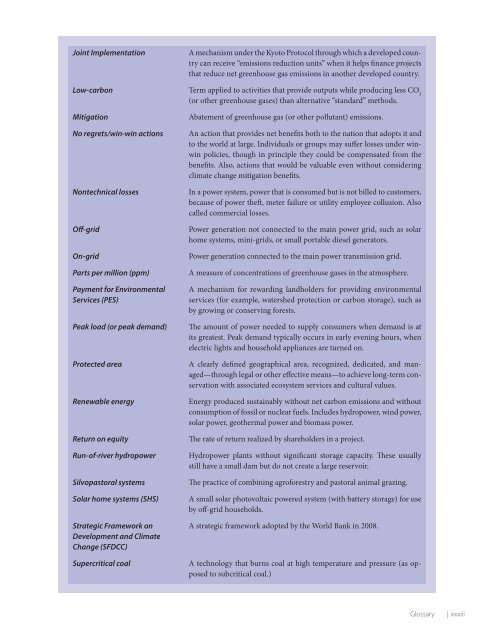The Challenge of Low-Carbon Development - World Bank Internet ...
The Challenge of Low-Carbon Development - World Bank Internet ...
The Challenge of Low-Carbon Development - World Bank Internet ...
Create successful ePaper yourself
Turn your PDF publications into a flip-book with our unique Google optimized e-Paper software.
Joint ImplementationA mechanism under the Kyoto Protocol through which a developed countrycan receive “emissions reduction units” when it helps finance projectsthat reduce net greenhouse gas emissions in another developed country.<strong>Low</strong>-carbon Term applied to activities that provide outputs while producing less CO 2(or other greenhouse gases) than alternative “standard” methods.MitigationNo regrets/win-win actionsNontechnical lossesOff-gridOn-gridParts per million (ppm)Payment for EnvironmentalServices (PES)Peak load (or peak demand)Protected areaRenewable energyReturn on equityRun-<strong>of</strong>-river hydropowerSilvopastoral systemsSolar home systems (SHS)Strategic Framework on<strong>Development</strong> and ClimateChange (SFDCC)Supercritical coalAbatement <strong>of</strong> greenhouse gas (or other pollutant) emissions.An action that provides net benefits both to the nation that adopts it andto the world at large. Individuals or groups may suffer losses under winwinpolicies, though in principle they could be compensated from thebenefits. Also, actions that would be valuable even without consideringclimate change mitigation benefits.In a power system, power that is consumed but is not billed to customers,because <strong>of</strong> power theft, meter failure or utility employee collusion. Alsocalled commercial losses.Power generation not connected to the main power grid, such as solarhome systems, mini-grids, or small portable diesel generators.Power generation connected to the main power transmission grid.A measure <strong>of</strong> concentrations <strong>of</strong> greenhouse gases in the atmosphere.A mechanism for rewarding landholders for providing environmentalservices (for example, watershed protection or carbon storage), such asby growing or conserving forests.<strong>The</strong> amount <strong>of</strong> power needed to supply consumers when demand is atits greatest. Peak demand typically occurs in early evening hours, whenelectric lights and household appliances are turned on.A clearly defined geographical area, recognized, dedicated, and managed—throughlegal or other effective means—to achieve long-term conservationwith associated ecosystem services and cultural values.Energy produced sustainably without net carbon emissions and withoutconsumption <strong>of</strong> fossil or nuclear fuels. Includes hydropower, wind power,solar power, geothermal power and biomass power.<strong>The</strong> rate <strong>of</strong> return realized by shareholders in a project.Hydropower plants without significant storage capacity. <strong>The</strong>se usuallystill have a small dam but do not create a large reservoir.<strong>The</strong> practice <strong>of</strong> combining agr<strong>of</strong>orestry and pastoral animal grazing.A small solar photovoltaic powered system (with battery storage) for useby <strong>of</strong>f-grid households.A strategic framework adopted by the <strong>World</strong> <strong>Bank</strong> in 2008.A technology that burns coal at high temperature and pressure (as opposedto subcritical coal.)Glossary | xxxiii
















